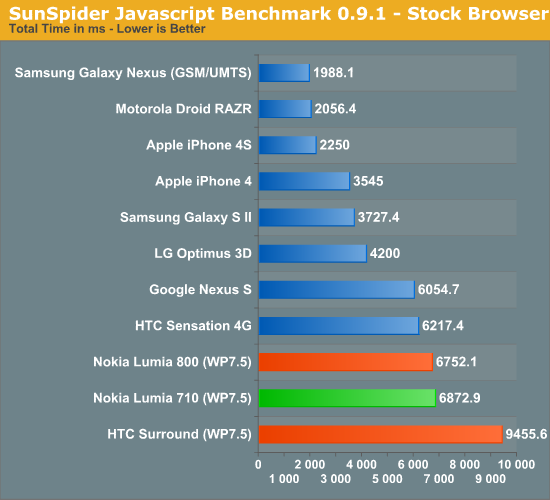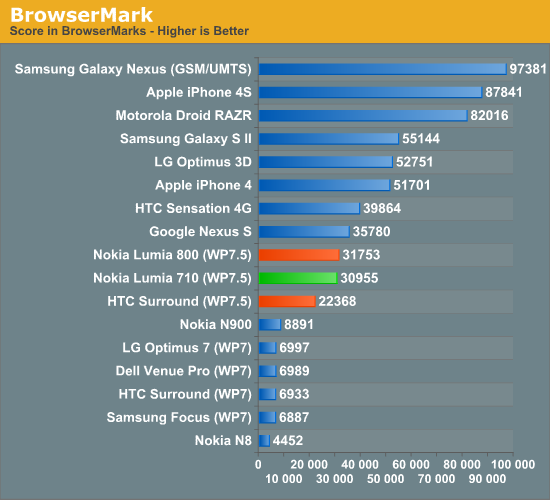Nokia Lumia 710 Review - T-Mobile's Nokia WP7
by Brian Klug on January 5, 2012 12:01 AM EST- Posted in
- Smartphones
- Nokia
- Mobile
- WP7
- Lumia 710
Performance
Unfortunately, the majority of benchmarks that usually grace our smartphone reviews don’t yet have WP7 ports or analogs, but there are a still a number of comparisons we can make. To start, the browser-based performance metrics give a good picture within the Windows Phone ecosystem, and likewise with WPbench, created by one of our own readers and on the marketplace.
This current refresh of WP7 devices continues to be based around exclusively Qualcomm SoCs, and the Lumia 710 is no exception. Both the 710 and 800 are based around Qualcomm’s MSM8255 single core S2 snapdragon at 1.4 GHz with Adreno 205 graphics at the core and dual channel LPDDR2 memory interfaces. This is a 45nm part we’ve seen and explored numerous times before, and as a refresher includes the HSPA+ 14.4 baseband onboard. At this point, there really only are three different SoC and clock configurations which WP7 has to deal with - 1.0 GHz QSD8x50 Snapdragon (65nm single core with Adreno 200 graphics), 800 MHz - 1.0 GHz MSM8x55/MSM7x30 Snapdragon (45nm single core with Adreno 205 graphics), and now a higher clocked 1.4 GHz MSM8x55 Snapdragon.
Those three configurations essentially tell the complete story of Windows Phone’s SoC evolution since launch, which are clearly outlined in their chassis requirements. I spent a paragraph in the Lumia 800 talking about why benchmarking will become even more important in the Windows Phone 7 / Windows 8 ecosystem as this opens up to more SoCs (and ST-E per Nokia’s influence), and how a huge number of benchmark players are busily porting the same Android/iOS benchmarks to the platform. Eventually WP7 will make the jump to dual-core as well.
Anyhow, onward to the numbers. First is sunspider, which we’ve been using for a long while and recently changed from 0.9 to 0.9.1 with. As a result, I’ve had to re-run devices since the numbers aren’t directly comparable. WP7.5 brings a much improved javascript engine which gives it a big boost in scores. I’ve managed to hang onto the HTC Surround (1.0 GHz QSD8250) which we’ve included as well.

I sound like I’m on repeat, but unsurprisingly we see the same performance we did out of the Lumia 800 (again both are using 1.4 GHz MSM8255) and a big jump thanks to running WP7.5. The new combination of IE9’s Trident 5.0 and Chakra JavaScript JIT engine also helps narrow the gap between iOS and Android in the JavaScript department. Obviously it can’t come close to matching the phones up there with dual core SoCs, however.
Browsermark hasn’t changed or forced us to re-run things, so we have comparison numbers from WP7 devices pre-update that show how much difference there is in the browser department in WP7.5.

Again here things are almost exactly on par with the Lumia 800, unsurprisingly. Unfortunately if you use the Nexus S (1.0 GHz S5PC110 “Hummingbird” with a Cortex A8 CPU) as a comparison point (vs the 1.4 GHz Scorpion inside MSM8255) you can see how the WP7 team needs to eek some more performance out to bring things totally up to parity. I should note that Nexus S number is for 2.3.6 as well, 4.0.3 puts things even further out of reach.
For system benchmarking on WP7.5 we have WPBench, which was created by one of our own readers. The benchmark reports a total score in addition to three sub-scores for CPU, memory, and GPU.
| WPBench Comparison | |||
| HTC Surround (1.0 GHz QSD8250) | Nokia Lumia 800 (1.4 GHz MSM8255) | Nokia Lumia 710 (1.4 GHz MSM8255) | |
| Total Score | 61.58 | 91.14 | 92.85 |
| Result Screenshot |
 |
 |
|
The rest of WP7.5’s UI in first party applications and the main navigation areas is very smooth, admittedly. It’s here that you really see the reasoning for many people arguing that WP7.5 doesn’t need to make the jump to dual-core very soon. Silverlight applications can occasionally stutter, however, it’s hard to fully codify the differences between first-party (native code) and third-party (Silverlight) performance until we get better tools.












48 Comments
View All Comments
PubFiction - Sunday, January 8, 2012 - link
Nokia may be working on their new core competency. Lots of companies do this same thing and roll just fine. Vizio, Apple to name a few. Do the design then outsource everything else.PubFiction - Sunday, January 8, 2012 - link
I should also add that nokia tried to make symbian work and they failed. They have gone from one of the worlds most recognised phone makers to almost nothing. I mean you can go into any phone provider in the US and I am not sure if you would see any nokia phones.So ya the whole making a competing OS in Europe thing just did not work out for them.
a5cent - Monday, January 9, 2012 - link
Symbian was not doomed due to it being developed in Europe. One of the main difficulties was that the developer was essentially a hardware company. Hardware and software development are very different, and requires a different company culture and different management. American hardware companies that attempt software almost always fail as well. Apple is probably the only exception... Apple is probably the worlds only systems company.Spivonious - Thursday, January 5, 2012 - link
Windows has poor multithreading? What are you talking about? Windows has supported multi-tasking (which is what I assume you mean, since only recently (last 5-10 years) have we gotten CPUs capable of operating more than one thread at a time) since Windows 1.0.WP7 has supported multi-tasking since launch. The API was opened up to 3rd party developers with the 7.5/Mango update.
As an owner of a WP7 phone and a user of iOS, Android, and RIM, I can veritably say that it is the best, most well-designed mobile OS out right now.
Apple doesn't make iPhones either. You may as well get over losing your factory job and realize that in the world economy, you make the product whereever you can get the best deal.
melgross - Thursday, January 5, 2012 - link
I haven't read past the first page yet, but the weights caught my eye. I don't know if the weight in grams is correct, or the weight in ounces, but there is a discrepancy.Assuming that grams is correct, the weight, in ounces, of the 800 should be 4.41, and the weight of the 710 is pretty close, but is then a bit more at 4.43.
jsv35 - Thursday, January 5, 2012 - link
Thank you for taking time and doing reviews on Windows Phone, it's always nice to see. I have an android device myself, but have always kind of liked the look of WP7zinfamous - Thursday, January 5, 2012 - link
Agreed.I don't follow the GPU and general hardware reviews as much as I used to, but the scope of those is what brought me to AT in the first place. I now see that same level of detail now with the phone reviews, and I would never purchase a phone without getting the skinny from AT first.
They have become the best on the web. Even the camera reviews are (were?) just as detailed at one time.
Kudos.
melgross - Thursday, January 5, 2012 - link
What I found interesting is that while neither the 800 or the 710 performed well, though as expected, the LCD screen of the 710 is MUCH brighter than the AMOLED screen of the 800, both phones performed much better than the extremely dismal performance of the N8, a phone which, for some unexplainable reason, is thought by some to be a super phone. To me, it seems a dud.kyuu - Thursday, January 5, 2012 - link
While integration/overlap with Windows on the PC and with the Xbox is certainly an interesting proposition and would be a boon, that's not what I (and probably a lot of others) are waiting for in order to jump ship to the Windows Phone platform. I love the WP UI, I love the *idea* (though not execution so far) of the controlled hardware platforms as opposed to Android's uncontrolled, fragmented mess and the singular, completely restricted iPhone platform.What I'm waiting for to jump are:
1) A more modern hardware platform. I understand all the arguments about why WP doesn't *need* a dual-core yadda yadda, but I have no interest in side-grading from my iPhone 4 to a hardware platform with pretty much exactly the same capabilities. I want an *upgrade* for my investment. And besides, when the hardware capability is there, the software that takes advantage of it will follow suit, and I've seen plenty of reports that 3rd-party Silverlight-based software does indeed suffer slowdown. I need at least a dual-core with a reasonably capable GPU.
2) I need an SD-card slot or some other way to increase the available storage. High-end devices with 8, 16, or even 32GB of NAND with no upgradability is simply not sufficient.
3) A quality screen with a pixel density that's at least competitive with what my iPhone 4 has. I don't want to downgrade to a screen that's looks worse.
I'm hoping by the end of this year with WP8 out, attractive hardware will be out so I can jump to the Windows Phone platform and never look back.
a5cent - Friday, January 6, 2012 - link
Excellent! I agree, and wonder how many other people feel similarly. I suspect you almost have to be a software developer to really appreciate the benefits of the controlled hardware platform. Microsoft's ability to guarantee that every WP device owner will get every update is one such benefit. However, other benefits that are more easily appreciated by end users have yet to materialize.I don't know about expandable storage, but we know the other issues will be resolved with WP8.
I'm also holding on to my current phone. I will also go for WP8 if:
a) we get very tight integration between W8 and WP8
b) we get some AAA applications and games directly from MS which make use of WP8 hardware